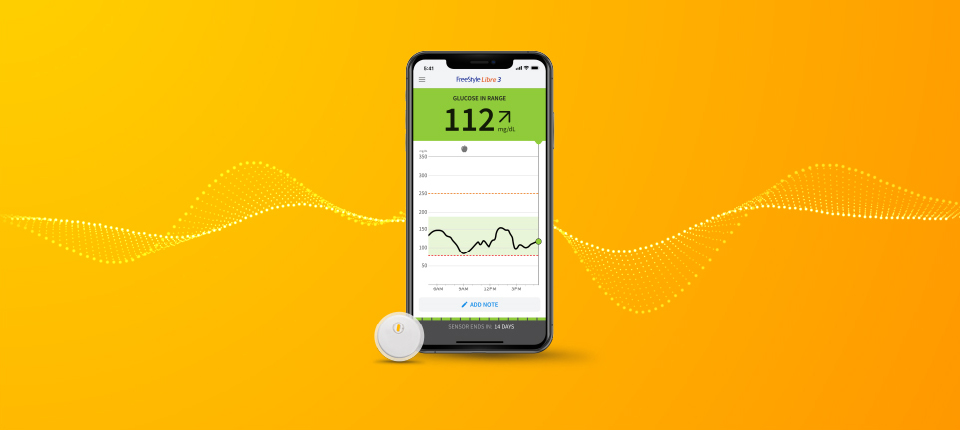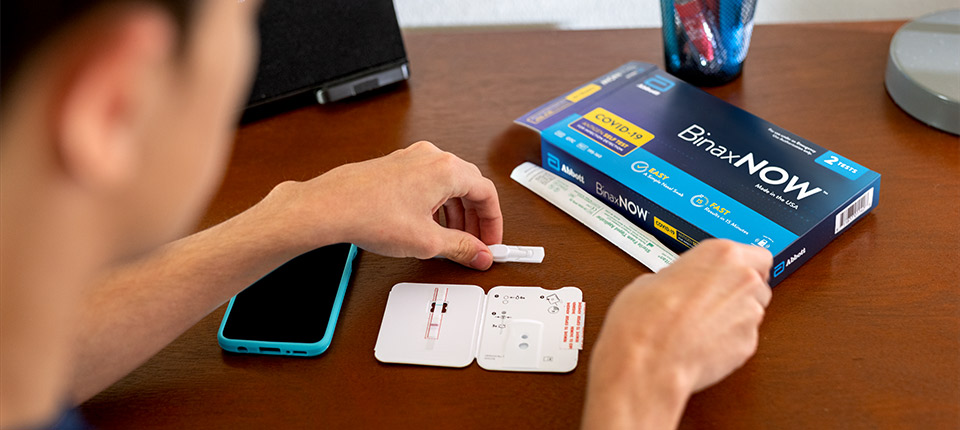For most people, completing an Ironman triathlon is enough goal-setting for one adulthood. Even playing out the 2.4 mile swim, 112 mile bike and 26.2 mile run in one's mind seems exhausting. But to Doug Lautner, Sr. Director, Software and Cybersecurity Research and Development for Abbott's Neuromodulation business, reaching that goal was both the culmination of numerous smaller accomplishments, and a small part of a much larger future vision he has for both himself and Abbott.
A vision that, in a few years, could result in the human body using advanced technologies to monitor changes occurring during that 100+ mile cycling leg and making automatic, real-time adjustments to optimize the body's ability to reach the finish line.
It is one of many goals he has in motion at any time, because Doug gets stuff done and he surrounds himself with a lot of people who like to do the same. They are the people of the Neuromodulation division, a team that develops specialized devices, including sophisticated "tiny tech," for people suffering from chronic pain and movement disorders through stimulation to the spinal cord, dorsal root ganglion (DRG) and brain.
So Little Time, So Many Degrees
There are certain tip-offs to this will-do aspect of his personality. There is the PhD in Computer Science, which is nice, but is it nicer than the three Masters degrees he has already earned (Computer Science, Electrical Engineering, Business) or the fourth he will soon receive, a Masters of Science in Applied Cognition and Neuroscience? There are also the scores of patents and academic papers across an array of disciplines and the innovative work at Google and Lenovo. That sort of thing.
But those may be no more telling about his priorities than the spin and bootcamp classes he likes to teach. They are an important foundational piece of what he does. Lautner believes strongly in the importance of physical fitness as it provides him the energy to fuel his active days, while also training others to operate at their peak levels. "Everyone deserves a good life and that starts with feeling your best physically.
"We all want to use our individual talents to improve lives, so if I can do that by teaching fitness classes while also helping to develop systems that improve management of chronic pain or movement disorders, I'm going to do what I can. Every person I train helps me get stronger. Any degree I pursue helps me improve my ability to help others. It's a cycle of positive feeding positive. That's what really drives me. I don't want to live with the regret of not doing everything I could," said Lautner.
So he does a lot of things, but not just to get things done. No compulsive list-maker is he. Rather, he sets out goals that ladder up to bigger goals, making certain that reaching each of those rungs has a payoff of its own, thereby fulfilling his primary goal at each step: to help people by giving back.
"I Wanted to Get Closer to the End User"
Lautner was first introduced to the world of neuromodulation several years back by a colleague at Google who explained how it was being used to treat several medical issues, including chronic pain and movement disorders, such as Parkinson's disease. Having lost two brothers to the ravages of cancer, Lautner was extremely interested in technology that could potentially reduce pain (though not the type caused by cancer).
"My brothers were my heroes and there are few things worse than seeing people you love in excruciating pain and you're not able to do anything about it. There are a lot of ways we can help each other as people, like donating food, giving to charities. Lots of things. But being part of a solution that could potentially ease some people's pain or reduce fear of not being able to control one's own body, seemed like a great place to contribute," said Lautner.
Having already garnered considerable success with technology giants, he wanted to experience a more personal touch. "I wanted to get closer to the end-user of the technology we were developing. To be part of the process that directly impacted patients and physicians. Abbott was a great fit, with a strong reputation and a desire to lead the pack in technology," said Lautner.
Tackling the Big Vision
Some employees show up at their new job with a map to the cafeteria and some password ideas. Doug Lautner? Not so much.
He had thoughts. Many thoughts.
Shortly after starting, Lautner presented to the leadership team a comprehensive look at what he envisioned for Abbott Neuromodulation over the next eight years. "We were looking toward the monumental idea of predictive, decentralized medicine so that wherever the patient was, we'd be able to provide them healthcare and, using artificial intelligence (AI), we could improve diagnosis and treatment, while also making it more accessible and affordable. We were determined to put together a solution that reduced the burden on patient and family, while increasing Abbott's level of service. It was a big vision but we had mapped out all the steps with timelines and highlighted the patient/physician benefits as we made our way forward.
"I like the example of the autonomous vehicle, which I rode in a prototype of several years back. Technologically, those cars could be operating today. We see the benefits of that work in new cars every year, from hands-free parking to collision-avoidance braking. But people need to feel confident with the big, new idea, which is why it needs to be iterative; evolutionary, rather than revolutionary for there to be the necessary comfort level that users will adopt.
"I've learned that you get the most done when you have a holistic vision of where you want to be at certain points in time. It's like training for a triathlon. You have to break it down into manageable pieces, accomplish those goals and build upon them," said Lautner.
Assembling the Team
"To accomplish all of our ambitious agenda, I knew we had to have the right people in place," recalls Lautner. "We already had a great team at Abbott and I was eager to add to it by pulling in an age, gender and culturally diverse group from my network and different industries. That variety of thought was crucial to me. While working on an advanced augmented reality/virtual reality project a couple of years earlier, we were prepping for a conference and there were numerous suggestions that centered around sports, motorcycles, engines, etc. A female on the team, however, suggested focusing on parenting concerns and we ended up with a great neonatal intubation presentation.
"I had been working with the WIE (Women in Engineering) subgroup of the IEEE (Institute of Electrical and Electronic Engineers) and, at first, being the only man at the meetings was pretty intimidating. It gave me a strong appreciation for not only what the women had to contend with, but also the extraordinary quality of the work. This just cemented my strong belief that a variety of viewpoints was absolutely necessary to best advance the technology and we were grateful to attract a team of top talent from several different industries."
Laying Down the Building Blocks
As the team came together, they also moved forward. With the support and guidance of a leadership team that included Keith Boettiger, Vice-president and Ryan Lakin, Divisional Vice-president, Neuromodulation, they innovated on a variety of fronts, from systems, to developmental operations, to how software was developed. They took on multiple projects in parallel and had prototypes built and presented to management so that they could see them in action, rather than just hear explanations. And they built the products in a logical sequence in support of the overarching plan.
The idea was to decentralize, so they needed to bring care to the patient at home. They needed to be mobile so they moved away from the idea of an iPod to a phone which had the advantages of connectivity, ubiquity, personalization and user trust. Once they had the app on the phone, they needed to build a secure infrastructure for the exchange of healthcare information, so they used the same NFC payment technology that protects financial transactions.
Like the autonomous car, people learn to trust new features on their devices and grow with them. "Every step we took had to be part of the larger goal, but there also had to be payoffs along the way that benefit the patients and doctors," said Lautner.
Those benefits have started to accumulate and will continue to build upon each other. They include:
- The NeuroSphere™ myPath™ app which allows patients to record their pain relief during the device trial period with spinal cord stimulation or DRG therapy, while simplifying reporting outcomes and connecting patients to physicians who have real-time access to this data; and
- The NeuroSphere™ Virtual Clinic which offers a telehealth service, from a patient's iPhone to their physician's iPad, but also allows for a digital prescription to be delivered, near-instantaneously, from the physician's iPad to a patient's brain, over the internet. This allows doctors to assess patients live, treat them over the internet, and assess the effects of the treatment, in real-time, without the patient having to leave home.
We Aren't Done Yet…
But this is just the beginning. Because from the time Lautner was working on his PhD, he was aiming for a future that combined AI and healthcare in a new way. He didn't just want to replicate the in-office visit, he wanted to improve upon it. In addition to talking to the patient and making visual assessment via video, the hope is to use the phone camera to perform a kinematic analysis of the patient's face and/or body (think of the dot matrix you see when movies make humans into CGI characters).
This process tracks movements and more, providing a wealth of data that can potentially highlight stress levels, involuntary facial/body movements, eye dilation and tone and pitch of voice. All of this can give physicians further insights into not only current conditions, but can be mapped to show time series data and provide augmented insights into the patient's pain and responses to changes in therapy.
This data on its own would be valuable but, when combined with similar data from tens of thousands of similar patients, it may allow clinicians to better understand what is occurring in the nervous system and lead to more accurate, predictive medicine. This Neuro Diagnosis and Prognosis AI technology would provide extraordinary insights into patient care and possible outcomes.
"We are steadily moving from 'no way' to 'this is going to help people', as credibility increases with each progression," said Lautner. "We believe the momentum will continue."
Still Not Done…
But the vision goes even further. As sensors improve, they will be able to transmit better data about what is going on in the body to devices that will make adjustments in real-time without active user involvement. Ubiquitous connectivity (like satellite, Wi-Fi and 5G) will improve data collection and transmissibility to healthcare providers so quality of life improvements can be continuous, not just during regularly scheduled visits. "Adjustments could be ongoing even while the person is sleeping," said Lautner.
Perhaps while dreaming of that 112 mile bike leg… We don't know what Doug Lautner is thinking about while he is swimming or biking or running or even dreaming, but it is a solid bet that it involves charting out the most efficient way to improve someone's life.






FOLLOW ABBOTT